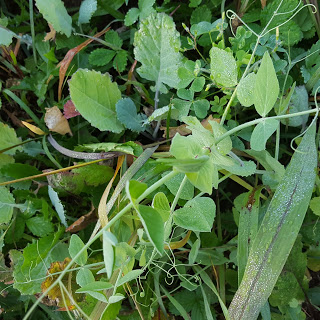
Food plots do not have to be kill plots or hunting locations. In my case, I have a small quarter acre supplemental feed plot. It is not really huntable as it is in my backyard and the deer tend to use it at night. But they do use it. It is in place to provide the herd with supplemental nutrition in the spring, summer and into the late season when food becomes scarce.
 |
| Ladino White Clover |
My plot consists of perennial clover and chicory. This plot is at the end of its life (I got 7 years out of it) and will be killed off soon with the ground worked, amended and replanted early to help my herd into the late spring and early summer months. In the late summer, I will again top the plot with rape and turnips to allow some fall and late season sustenance.
Growing clover is not a difficult proposition either. Perennial clovers tend to establish slowly, so I like to mix in annual clover along with the perennial variety when first starting a food plot. The annual clover will establish quickly, providing food for the whitetails and suppressing weed growth while the perennial crop establishes itself.
 |
| Crimson clover |
The annual clover that I am going with is crimson clover. This variety is a great choice because it is attractive to deer, has a high protein content, and grows well in most soil types. Soil pH range can be as low as 5.7 but it prefers soil with a ph of 6.7 – 7.0. Nutritional content includes 25% crude protein during the spring growing season which is 80% digestible. Even more impressive is the 12 to 14% crude protein content that is 65% digestible even at full bloom. This early protein content is the perfect jumpstart for a winter-ravaged herd.
 |
| Chicory |
Chicory is a unique perennial plant in the sunflower family. It looks a lot like a common weed called plantain, but don’t let its looks fool you. Chicory is a great addition to your whitetail food plot, is a perennial plant and provides 15 to 30 percent crude protein to the herd. In addition, chicory provides magnesium, calcium, sodium, manganese, potassium, vitamins A, B6, C, E & K. With an ideal pH of 5 -7.5, chicory fits well with the clover in the food plot. Chicory can be mowed along with perennial clover varieties and will last up to 5 years.
 |
| Dwarf Essex Rape |
Brassica plant palatability increases with the first frost. Sugars from the roots are drawn up into the leaves with the first frost and the plants become magnets to the whitetails. The leaves become sweet and will be consumed first. As winter progresses, whitetail deer will dig up the bulbs from the turnips providing further nutrition.




